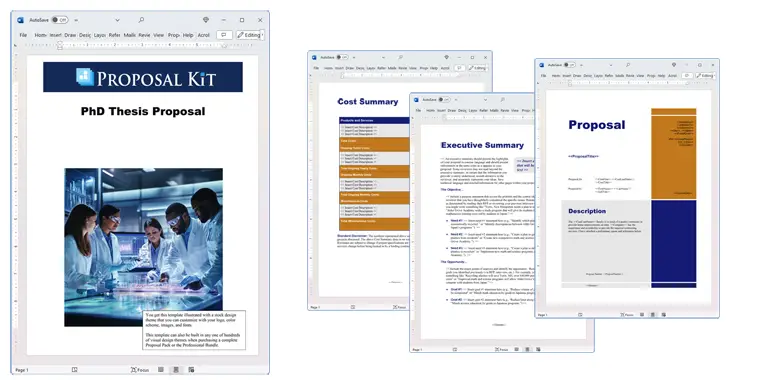How to write your PhD Thesis Proposal
We include this 30 page layout with every Proposal Pack. If you want this template to have a different visual design theme than the one illustrated here, purchase any Proposal Pack design and create this template using the purchased design theme. This template is included in every Proposal Pack. If you get a Proposal Pack or the Professional, you can also make any variation of this template with different chapters to suit your needs.
We typically include more chapters in the templates than most people will need to give everyone more variety in the chapters they may need. You can trim down a long template by removing pages you do not need or combining multiple chapter topics into one page.
 DOWNLOADABLE, ONE-TIME COST, NO SUBSCRIPTION FEES
DOWNLOADABLE, ONE-TIME COST, NO SUBSCRIPTION FEES If you need only this template pre-assembled on DVD media order from our Amazon shop.
If you need only this template pre-assembled on DVD media order from our Amazon shop.
You can also create countless variations of this document to suit your needs using the included library of 2200+ chapters if ordering a Proposal Pack or Professional.
 What Our Clients Say
What Our Clients SayI am really grateful from your product, your proposals are really very academic, and longer. I used them in my business and I won the contracts in international levels. Thank you very much for your great products."
Access Point Group
Kabul, Afghanistan
Related Article
Related Video
Related Templates
- Extinction and Climate Change Study
- Climate Change Research Proposal
- Research Assistant Proposal
- Medical Research Project Funding Proposal
- Artificial Intelligence Project Funding Proposal
- Drug Synthesis Project Funding Proposal
- Research Funding Request Proposal
- Medical Clinic Project Proposal
- Logistics Research Project Proposal
- International Research and Development Project Proposal
- Research Expedition Grant Funding Request
- Due Diligence Project Proposal
- Research Proposal (Long)
- Research Proposal (Short)
What's the best way to write your PhD thesis proposal?
The most efficient solution to writing a PhD thesis proposal is to use the Proposal Kit template and software package. This tool simplifies the creation of your documents and integrates a comprehensive quoting database system for managing cost summaries, quotes, estimates, budgets, and other financial details crucial to your research. Do you need to write a thesis proposal, or will you be doing so soon? If yes, the Proposal Kit is your solution.
What Types of Projects Are PhD Thesis Proposals Written For?
PhD thesis proposals are created for various situations. Here are some examples of projects where a well-structured thesis proposal is used:
- Investigating climate change impacts on marine biodiversity
- Exploring the correlation between social media usage and mental health
- Developing new algorithms for data encryption
- Studying ancient texts through digital humanities
- Conducting clinical trials for a new pharmaceutical drug
- Researching nanotechnology applications in electronics
- Examining economic models for sustainable development
- Analyzing political strategies in international relations
- Investigating genetic markers of hereditary diseases
- Developing AI models for predictive analytics in sports
- Studying behavioral patterns in consumer shopping
- Researching renewable energy solutions in urban areas
- Examining historical migration patterns and their effects
- Investigating materials science for better construction materials
- Developing educational software for adaptive learning
- Examining the effects of dietary habits on long-term health
- Researching quantum computing's impact on cybersecurity
- Investigating sociocultural impacts on language development
- Examining the role of public policy in health inequalities
- Developing virtual reality therapies for PTSD treatment
Chapters this template is built with
A PhD thesis proposal needs to capture the essence of your research in a structured and clear manner. Proposal Kit allows you to customize your proposal with various chapter templates from their extensive library. Here's how you can use some of these chapters:
Cover Letter
The Cover Letter serves as your initial handshake with the review committee. Introduce yourself, mention your academic background, and briefly outline your research goals. Explain why your research is significant and how it contributes to your field, immediately capturing the reader's interest.
Abstract
The Abstract is a concise summary of your research topic, methodology, and significance. It should provide a snapshot that allows readers to understand the core topics of your proposal quickly. Include key findings or expected outcomes to highlight the importance of your study.
Thesis
In the Thesis section, present your main thesis statement or hypothesis clearly and precisely. This is the foundation of your entire research and should be specific, measurable, and researchable. This section sets the stage for everything else in your proposal.
Goals and Objectives
The Goals and Objectives section details what you intend to achieve through your research. Specify your primary research goals and break them down into smaller, actionable objectives. This helps reviewers understand what you aim to discover and the steps you will take to get there.
Scope
The Scope section defines the boundaries of your research. Specify what will be covered and not included in your study. This helps manage expectations and delineates the focus of your research.
Project Plan
Outline the steps you will take to complete your thesis in the Project Plan section. Include a detailed timeline, significant milestones, and the sequence of tasks. This section should demonstrate your planning and organizational skills.
Experiments
Describe any experimental work you plan to conduct in the Experiments section. Detail the controls, variables, and expected outcomes. Explain how these experiments are crucial to validating your thesis.
Site Selection
In the Site Selection section, explain why you have chosen specific locations or data sources for your research. Justify your choices based on relevance, accessibility, and the potential to yield meaningful data.
Data Collection
Describe the methods you will use to gather data in the Data Collection section. Include the data types, sources, and techniques such as surveys, fieldwork, or archival research. Ensure that your methods are robust and appropriate for your research objectives.
Methodology
The Methodology section details the procedures and techniques you will use to analyze the data. Explain why these methods suit your research and how they will help you address your research questions or hypotheses.
Research
The Research section should review relevant existing research and explain how your work will build on or challenge it. It should also highlight gaps in current knowledge and explain how your study will fill these gaps, contributing to the academic field.
Fieldwork
If applicable, describe any fieldwork in the Fieldwork section, including logistical details. Mention any required travel, equipment, or special permissions, and explain how fieldwork will contribute to your research goals.
Background
Provide the necessary historical or contextual background that informs your research in the Background section. This helps situate your study within a broader academic context and demonstrates your understanding of the field.
Time Line
Provide a timeline for the different phases of your research project in the timeline section. Include key milestones and deadlines to show that you have a realistic plan for completing your research on time.
Limitations
Discuss potential limitations in your research and how you plan to address them in the Limitations section. Acknowledge any constraints and explain how you will mitigate their impact on your study.
Models
If your research involves theoretical or physical models, describe them in the Models section. Explain how these models will be developed, tested, and validated and how they relate to your research objectives.
Resources
The Resources section lists resources you will need, from laboratory equipment to library archives. Detail any special tools, software, or materials important to your research.
Assumptions
State any assumptions that your research is based on in the Assumptions section. This helps clarify the foundational beliefs or conditions upon which your study is predicated.
Measurements
The Measurements section details the metrics and methods you will use to measure data. Explain how these measurements are relevant to your research objectives and how they will be analyzed.
Results
Explain how you will present and interpret the results of your research in the Results section. Include plans for data visualization, statistical analysis, and any other methods you will use to convey your findings.
Validation
Describe how you will validate your results and conclusions in the Validation section. Explain the steps you will take to ensure the reliability and accuracy of your findings.
Budget
Use the Proposal Kit's financial tools in the Budget section to detail your projected costs and funding needs. Include estimates for equipment, travel, personnel, and other expenses to show that your research is financially feasible.
Conclusions
Draw preliminary conclusions based on your proposed research and expected results in the Conclusions section. Summarize the potential impact of your study and how it advances the field.
References
List all scholarly works and sources you cite or plan to consult in the References section. Ensure that your citations are formatted according to the appropriate academic style.
Diagrams
The Diagrams section includes diagrams explaining complex concepts or planned research methodology. Visual aids can help clarify intricate details and make your proposal more comprehensible.
List of Acronyms
Provide a list of acronyms used in your proposal for clarity in the List of Acronyms section. This ensures that readers can easily understand any specialized terminology.
Appendices
Include any additional data or material that supports your proposal but is too extensive for the main text in the Appendices section. This can include supplementary data sets, detailed methodologies, or extended literature reviews.
Use cases for this template
Transforming Environmental Research
The Challenge
Maria faced the challenge of an extensive study on urban pollution's impacts on public health. With a background in environmental science, she recognized the pressing need for this research but needed to gain the experience to present her project organizationally. Moreover, she needed a comprehensive proposal that could win grant funding from a prestigious environmental foundation. The task seemed overwhelming, particularly given the complex data collection and analysis methods.
The Solution
Maria chose the Proposal Kit to create her detailed proposal efficiently. The software's extensive library of templates allowed her to focus on the research rather than the formatting. Proposal Kit's integrated line item quoting system helped her outline the financial topics comprehensively, ensuring that her budget was as persuasive as her scientific arguments.
The Implementation
Using the Proposal Kit, she outlined her research framework. She included chapters on her thesis, goals, objectives, and detailed data collection and methodology sections. The budget templates allowed her to present a clear and feasible financial plan. Maria also included a timeline and a thorough review of existing literature to support her proposal.
The Outcome
The grant committee praised her proposal's clarity and thoroughness. The detailed budget and clear methodology assured them of the project's feasibility. As a result, Maria secured the necessary funding to proceed with her research, enabling her to comprehensively investigate and address urban pollution's impacts on public health.
Innovative Solutions in Technology
The Challenge
Tom needed to propose a new AI-based traffic management system to reduce city congestion. As a doctoral candidate in computer science, he had developed an innovative algorithm but struggled to communicate its potential impact. The project required substantial funding and approval from multiple stakeholders, including city planners and technology investors, making the proposal's clarity and persuasiveness critical.
The Solution
Using Proposal Kit, Tom could outline his innovative project. The software's range of templates allowed him to present each topic of his project, from the technical details to the projected societal benefits. The financial tools included in the Proposal Kit helped him create a realistic and detailed budget, an essential component for gaining stakeholder approval.
The Implementation
Tom used various templates to detail each part of his project. He included sections on the thesis, goals, objectives, and a comprehensive project plan. The methodology section detailed his AI algorithms, while the data collection chapter explained how real-time traffic data would be used. Tom also included a detailed timeline and a budget, which were crucial for gaining funding approval.
The Outcome
Tom's proposal was accepted. The stakeholders were impressed by the project's potential impact and the thoroughness of Tom's planning. He received the funding required to initiate the project and began implementing his AI-based system, which promised to significantly reduce traffic congestion and improve the city's overall traffic management.
Advocating for Social Change
The Challenge
Anita, a director at a non-profit, needed to write an RFP for a project addressing homelessness. The organization aimed to partner with a tech company to develop an app that could connect homeless individuals with important services. However, Anita struggled to articulate the project's scope and potential impact professionally and compellingly, especially given the subject's sensitive nature.
The Solution
Anita used Proposal Kit to create an RFP highlighting the critical need areas. The software's structured templates allowed her to clearly present the project's goals and objectives. Proposal Kit's financial tools enabled her to outline a comprehensive budget, which is important for attracting potential partners.
The Implementation
Using the Proposal Kit's structured templates, she detailed the project scope, goals, and impact it aimed to achieve. Anita wrote sections on the project plan, methodology, and required resources. She also included a comprehensive timeline and a detailed budget. The Proposal Kit helped her articulate the project's expected outcomes and the benefits for the homeless community clearly and compellingly.
The Outcome
The RFP attracted several high-quality responses from tech companies interested in partnering with the non-profit. The project was successfully launched with a suitable partner, and the app began development. The initiative promised to make a significant impact by connecting homeless individuals with important services, demonstrating the power of a well-written RFP in driving social change.
Conclusions and Recommendations
Proposal Kit's versatility and comprehensiveness can significantly simplify writing a PhD thesis proposal. Proposal Kit provides all the tools for students and researchers to succeed in their academic pursuits, from creating individual chapters to managing budgets.
Also Known As
This template may also be referred to in different ways or be used in more specialized situations, such as:
- PhD Research Proposal
- Doctoral Thesis Submission
- Dissertation Plan
- PhD Proposal Outline
- Thesis Project Proposal
- Graduate Research Proposal
- Doctorate Proposal Draft
- PhD Topic Proposal
- Academic Thesis Proposal
- Research Dissertation Proposal
Abstract
 Creating a PhD thesis proposal is a vital stride in the journey of attaining a research degree, requiring meticulous planning and articulation. A successful proposal not only establishes the dissertation topic but also serves as an invaluable guide throughout the research process. The thesis committee, comprised of faculty and department members, plays a key part in this task, evaluating the proposal's depth and feasibility. As a general rule, your proposal should include a comprehensive overview of relevant literature, highlight gaps in current research, and suggest how your own work will address these lacunae.
Creating a PhD thesis proposal is a vital stride in the journey of attaining a research degree, requiring meticulous planning and articulation. A successful proposal not only establishes the dissertation topic but also serves as an invaluable guide throughout the research process. The thesis committee, comprised of faculty and department members, plays a key part in this task, evaluating the proposal's depth and feasibility. As a general rule, your proposal should include a comprehensive overview of relevant literature, highlight gaps in current research, and suggest how your own work will address these lacunae.
Selecting the right person as a supervisor or advisor can significantly impact the proposal's refinement, providing practical guidance and advice aligned with university guidelines. Careful data analysis and an articulate methodology are crucial components, allowing the committee members to appreciate your preparedness and the soundness of your approach. The Proposal Kit, with its extensive content libraries and complex document assembly features, can help streamline the preparation process, ensuring a well-structured proposal.
Preparing a detailed project outline, including a timeline and budget, is important, as is the introduction of clear goals and objectives. Committees look for thoughtful descriptions of the planned experiments and data collection methods, as these demonstrate foresight in solving the research problem. Ultimately, a well-drafted proposal is a general tip for success, as it proves the student's capability to carry out rigorous investigation, answer critical questions, and produce meaningful contributions to their field, paving the way for the successful completion of their degree.
 When preparing a PhD thesis proposal, it is important to recognize its impact and importance for one's academic and professional future. The proposal serves as a formal plan and a foundation for the research that will be undertaken, providing structure and guidance throughout the process. It is not merely a document to fulfill an academic requirement but a powerful tool to communicate the research philosophy and objectives to the thesis committee. As you submit your proposal, it is crucial to consider how it will be evaluated by a group of experienced faculty and department members who will closely examine its merits.
When preparing a PhD thesis proposal, it is important to recognize its impact and importance for one's academic and professional future. The proposal serves as a formal plan and a foundation for the research that will be undertaken, providing structure and guidance throughout the process. It is not merely a document to fulfill an academic requirement but a powerful tool to communicate the research philosophy and objectives to the thesis committee. As you submit your proposal, it is crucial to consider how it will be evaluated by a group of experienced faculty and department members who will closely examine its merits.
Incorporating general tips like organizing the proposal into clear sections such as introduction, goals, and methodology can immensely aid in presenting a coherent narrative. Using the Proposal Kit can be incredibly helpful in this effort, as it simplifies document assembly and brings together a team of templates to address all necessary components. The Proposal Kit can form the backbone of the proposal, providing a structure that supports detailed sections on data analysis and key discussions that will drive the research.
As the proposal takes shape, consider the next steps, such as the timeline for completing various research phases and the resources required to realize the project. It's important to note that preparing a proposal requires significant effort and a collaborative approach, often involving input from advisors and peers to refine ideas and strategies. This collaboration can ensure that the proposal is both comprehensive and compelling, positioning it for success.
 Looking to the future, a well-prepared proposal not only facilitates the current research but also lays the groundwork for future scholarly endeavors. It is a document that represents the candidate's capability and commitment to advancing knowledge within their discipline. In the course of this journey, the obvious advantages of using structured tools become apparent, making the entire proposal preparation process more efficient and effective. In this way, the Proposal Kit becomes an invaluable resource, offering a structured yet flexible framework to bring academic aspirations to fruition.
Looking to the future, a well-prepared proposal not only facilitates the current research but also lays the groundwork for future scholarly endeavors. It is a document that represents the candidate's capability and commitment to advancing knowledge within their discipline. In the course of this journey, the obvious advantages of using structured tools become apparent, making the entire proposal preparation process more efficient and effective. In this way, the Proposal Kit becomes an invaluable resource, offering a structured yet flexible framework to bring academic aspirations to fruition.
In the intricate journey of writing a PhD thesis proposal, one must appreciate not only the academic rigor but also the planning that goes into developing a document of such significance. A thesis proposal is more than a preliminary outline; it is a roadmap that guides the entire research task. It requires a multifaceted approach that incorporates both analytical and creative thinking to anticipate potential challenges and address them.
A critical topic of this process is fostering a sense of collaboration and open discussion with your academic peers and advisors. Engaging in these discussions can provide new perspectives and insights, helping to refine the research question and methodology. Such collaborative efforts are vital as they allow you to evaluate your ideas critically, ensuring they withstand scrutiny from the thesis committee.
 Moreover, the proposal acts as a reflection of the candidate's overall research philosophy, illustrating how they intend to contribute to their field. It is important to articulate how your research aligns with existing literature and addresses pressing issues, which demonstrates an understanding of the academic landscape and the proposal's relevance to contemporary debates.
Moreover, the proposal acts as a reflection of the candidate's overall research philosophy, illustrating how they intend to contribute to their field. It is important to articulate how your research aligns with existing literature and addresses pressing issues, which demonstrates an understanding of the academic landscape and the proposal's relevance to contemporary debates.
A well-written proposal also includes a clear timeline, which is not just a formality but a tool that helps manage the research process efficiently. Establishing key dates and milestones ensures that the project remains on track and that resources are allocated. It also demonstrates to the committee that the candidate has a practical plan for achieving their objectives, which is crucial for gaining their confidence and support.
Furthermore, the proposal's budget section should reflect a thoughtful consideration of the resources needed, from financial to human capital. This comprehensive outlook ensures that all topics of the research are well-planned and sustainable.
 In essence, creating a PhD thesis proposal is an exercise in thinking, organization, and communication. It is an opportunity to showcase one's dedication to advancing research and making a meaningful impact in the academic community. By using the Proposal Kit, candidates can streamline this complex process, ensuring that their proposals are not only thorough and well-organized but also compelling and innovative in their approach to solving important research questions.
In essence, creating a PhD thesis proposal is an exercise in thinking, organization, and communication. It is an opportunity to showcase one's dedication to advancing research and making a meaningful impact in the academic community. By using the Proposal Kit, candidates can streamline this complex process, ensuring that their proposals are not only thorough and well-organized but also compelling and innovative in their approach to solving important research questions.
Frequently Asked Questions
What should be the primary focus of my PhD thesis proposal?
Your PhD thesis proposal's primary focus should be clearly articulating the research problem you intend to address and how you plan to tackle it. It should also demonstrate a thorough understanding of the existing literature, identify a knowledge gap, and explain how your research will fill it. A well-defined thesis statement and detailed goals and objectives will make your proposal more compelling. Using the Proposal Kit template can help structure these topics, ensuring your proposal is comprehensive and focused.
How detailed should my methodology section be in a PhD thesis proposal?
The methodology section of your PhD thesis proposal should be detailed enough to convince evaluators that you have a feasible and well-thought-out plan for conducting your research. It should include specific data collection and analysis methods and justify their appropriateness for your study. Using Proposal Kit, you can leverage templates that guide you through outlining your methodology, ensuring that all critical topics are covered and presented clearly and logically.
Why is the literature review important in a PhD thesis proposal?
The literature review in your PhD thesis proposal contextualizes your research within the existing body of knowledge. It demonstrates that you understand your topic's key theories, concepts, and previous studies. This section should highlight gaps or limitations in current research that your study aims to address. Proposal Kit offers templates that can help you organize your literature review, ensuring that it is comprehensive and supports the significance of your research.
How can I present my research timeline in a PhD thesis proposal?
An effective research timeline in your PhD thesis proposal should outline the key phases of your research and provide realistic deadlines for each stage. It should include milestones for completing literature reviews, data collection, analysis, and writing. Clear timelines help reviewers understand the feasibility and planning of your research project. Proposal Kit includes timeline templates you can customize to fit your project, making presenting a detailed and organized schedule easier.
What financial details should I include in the budget section of my PhD thesis proposal?
The budget section of your PhD thesis proposal should provide a detailed breakdown of all anticipated expenses, including costs for materials, equipment, travel, data collection, and any other relevant items. It should also mention the sources of funding you plan to tap into. An accurate and clear budget helps reviewers assess the viability of your research. Proposal Kit's line item quoting database system can assist you in creating a comprehensive and precise budget, ensuring that all financial topics of your research are well-documented.
20% Off Discount
![]() Add To Cart This Word Template
Add To Cart This Word Template
 Add To Cart Proposal Pack for Any Business
Add To Cart Proposal Pack for Any Business
 Add To Cart Proposal Kit Professional
Add To Cart Proposal Kit Professional
 4.7 stars, based on 848 reviews
4.7 stars, based on 848 reviewsProposal Kit chapters used in this template
Cover Letter, Title Page, Table of Contents, Abstract, Background, Thesis, Scope, Goals and Objectives, Assumptions, Project Plan, Resources, Methodology, Time Line, Research, Models, Site Selection, Fieldwork, Experiments, Data Collection, Measurements, Results, Validation, Limitations, Budget, Conclusions, Appendices, References, Diagrams, List of Acronyms, Back Page
Line Item Automated Chapters
If you purchase a Proposal Pack or the Professional Bundle, these proposal pages are generated using an automated line-item database in the included Wizard software.
Time Line, Budget Three Year
You use this proposal for
- Education, training proposal
- Technical proposal
- Student project proposal
- Research, science proposal
How to create this template with Proposal Pack Wizard
You can create this document using any of the logo-designed Proposal Packs. Pick any Proposal Pack with a logo design theme you like best; they will all work equally well. The Proposal Pack for Any Business is the pack with no extra added logos or colors - designed to be used plain or for you to customize with your logos and graphics.
The Proposal Pack design theme you purchase will determine the visual look of this template. The screenshot above only shows the plain generic design theme.
We include a library of chapters to be assembled based on your needs. All proposals are different and have different needs and goals. We designed Proposal Pack so you can customize the documents to suit your needs.
You will best create this document using the Proposal Pack Wizard - Expert Edition software to select this template and build it in the Proposal Pack logo design theme of your choice along with any desired customizations (such as adding additional chapters, removing unneeded chapters, changing the order of chapters, and importing your company logo). This template outlines a proposal for the described situation. Each user is responsible for typing in the actual content of the provided pages with their information to complete the proposal. Suggestions in the abstract may include features in higher-end packages and are facilitated by the selection of chapter templates to support the narrative of each proposal, which help guide the user in filling in the details.
The Wizard software's AI Writer will write the content of the pages of the template based on details provided for your company, client, project, financial details and other writing instructions. This will provide a personalized version of the template completely written and ready to edit.
Once finished, the AI Writer's Word-to-PowerPoint converter can transform your proposal, business plan, or other business documents into a PowerPoint slideshow. Save time and effort by letting the AI analyze every chapter to condense its content into talking points, visually matching the document, and providing a consistent package of presentation material with the click of a button.
You create this template using the Wizard software with an entire Proposal Pack library and software. We include the Expert Edition of the software in the Proposal Kit Professional. Microsoft Word for Windows is required to use the customizing software. You can also edit Word document templates in other office software such as Word for Mac. We will assist Mac users in assembling complex templates for their first project if they do not have the required platform to run the Wizard software.
How to Build Templates Featured on Proposal Kit Website
Many people find the Proposal Kit website after searching for a specific proposal. Once you've purchased and installed the software, how do you build that template you found in the first place? This video shows you how to build any proposal you see on the Proposal Kit website.
 Ian Lauder has been helping businesses write their proposals and contracts for two decades. Ian is the owner and founder of Proposal Kit, one of the original sources of business proposal and contract software products started in 1997.
Ian Lauder has been helping businesses write their proposals and contracts for two decades. Ian is the owner and founder of Proposal Kit, one of the original sources of business proposal and contract software products started in 1997.By Ian Lauder
 Published by Proposal Kit, Inc.
Published by Proposal Kit, Inc.


 Cart
Cart
 Get 20% off ordering today:
Get 20% off ordering today: 


 Facebook
Facebook YouTube
YouTube Bluesky
Bluesky Search Site
Search Site